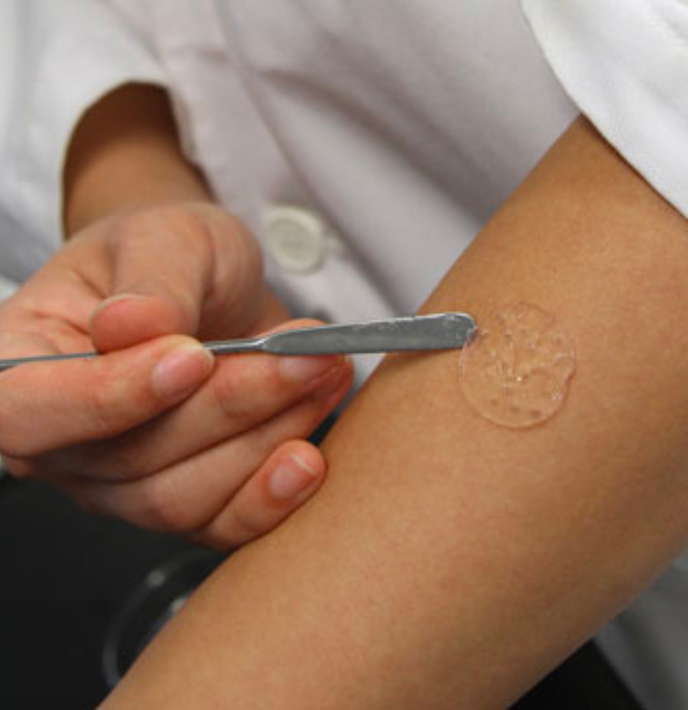Skin Tissue Regeneration
- Vyapti Shahani Subramaniam
- Aug 9, 2022
- 3 min read
Updated: Aug 9, 2022
When wounded, how does skin heal itself? Click here to learn about how our skin maintains itself!

Figure 1: A woman applying medicine to her healing skin
Introduction
The skin is the largest organ of your body, and it serves as a protective barrier against external forces. Skin regeneration is a naturally occurring process where cells grow rapidly, or proliferate, to heal damaged skin. In other words, skin regeneration is the total replacement of injured tissue with new tissue.
Skin Burns
Unfortunately, the skin regeneration process does not always occur properly in cases in which skin damage is too great for the body to regenerate skin cells on its own. One common instance when this occurs is with burns. According to the World Health Organization, burn injuries are when the skin is harmed due to heat, radiation, chemicals, or electricity. Burns can cause the body's inflammatory response, or the response that occurs after tissue injury, to overreact, causing the burn to become worse. Large fluid loss can also happen, causing a possibly fatal blood pressure drop in the body called shock. Finally, burned skin can get infected by dangerous pathogens, due to it losing its protection layer, making it much easier for bacteria and other invaders to enter the body.
All of these issues can occur in the body after a burn injury because the body’s natural skin regeneration response cannot regenerate and repair the skin tissue of some burns. Because of problem, scientists have developed skin tissue regeneration therapy to treat these burns. These treatments, including growth factor therapy, tissue scaffolds, and cell spraying, will induce cells to grow and heal the skin of the burn injury.
Methods of Skin Tissue Regeneration
One method of skin tissue regeneration is growth factor therapy, which is using growth factors to promote the healing of wounds. Growth factors are molecules secreted by the body that are involved in stimulating the growth of cells that are a part of skin wound healing. This therapy will increase the amount of those cells that help heal the skin, which then makes burn wounds heal faster. Growth factor therapy is delivered to the surface of the body, or topically.

Figure 2: An example of a scaffold used to heal burns.
Another method of skin tissue regeneration is the use of tissue scaffolds to help skin wound healing. Tissue scaffolds are engineered skin substitutes made to promote wound healing. Scaffolds will mimic the environment in real tissue where cells can function normally. The tissue will be placed over the damaged burn area and allow cells to proliferate.

Figure 3: The machine used in cell spraying to distribute cells onto the burn area.
A third technology of skin tissue regeneration is cell spraying. Cell spraying treatment is when skin from the patient is mixed into a solution containing cells that are essential for wound healing. This mixture is then sprayed on top of the burn injury, distributing live cells on an even layer on the wound and helping the skin heal. Cell spraying is used to treat large, deep burns. The common injury of the burn can damage the skin to a point where the body cannot heal and independently grow new cells in the burn region. This lack of cell proliferation in the injured area can lead to many health problems, including a broken inflammatory response and infections. To combat this, scientists have developed skin tissue regeneration techniques, including growth factor therapy, tissue scaffolds, and cell spraying. These therapies cause cells to grow in the burn injury region and help the wound healing process occur faster.
Citations:
https://stemcellres.biomedcentral.com/articles/10.1186/s13287-019-1203-3
https://www.woundcarecenters.org/article/wound-therapies/growth-factor-therapy
https://www.ncbi.nlm.nih.gov/pmc/articles/PMC7563417/#:~:text=An%20ideal%20scaffold%20fo%20r%20wound,%2C%20proliferation%20and%2For%20differentiation
https://www.technologyreview.com/2009/11/05/264930/spraying-on-skin-cells-to-heal-burns/






Comments